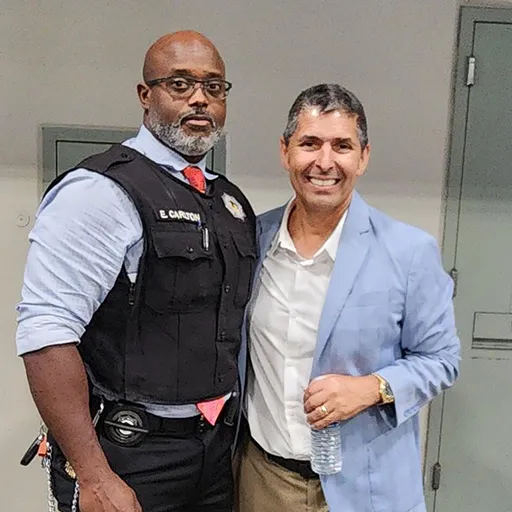FCC Coleman, Day 1

I am deeply grateful to Complex Warden Shannon Withers at Federal Correctional Complex (FCC) Coleman, the largest federal prison complex in the nation. The facility includes two high-security penitentiaries, two medium- and low-security federal correctional institutions, and one minimum-security camp. Executive Assistant Wendell Stallings coordinated the visit, and I’m certain it would not have been possible without the support of Deputy Director Josh Smith and Regional Director Andy Matevousian. In fact, Deputy Director Smith sent an email to assure me that he would be letting all staff members in the agency understand the importance of our program. At FCC Coleman, I felt welcomed and a lot of support from the people I met.
Advancing Change Through Direct Engagement
At Prison Professors, our advocacy depends on building relationships with the people who work inside the system. To change policies or laws, we must also change perspectives—one conversation at a time. That’s why our team has made a commitment to visit as many institutions as possible. Each visit strengthens our collective push for meaningful reforms that reward personal growth and accountability.
During my visit to Coleman yesterday, I began with a meeting in the Warden’s Conference Room. I had the privilege of meeting with members of the Executive Staff, including Warden Carlton, who oversees USP 2 and the medium-security facility, and Warden Anthony Mendoza, who oversees the low-security institution and the camp.
Conversations That Drive Reform
Mr. Stallings opened the meeting by describing Coleman’s vast scale and mission. After introductions, I summarized Prison Professors’ history and our advocacy goals—particularly, efforts to expand opportunities for people in custody to transition from higher to lower security levels, and ultimately, to home confinement or work-release programs when eligible.
Reentry Affairs Coordinator Mr. Talbott expressed his full support for these initiatives. Although a recent incident at USP 1 resulted in a lockdown—preventing me from presenting there—Mr. Talbott assured me he would encourage full participation when operations resume. The staff’s engagement and curiosity were inspiring. I answered questions about the structure and outcomes of our program and emphasized our role as a collaborative partner aligned with the Bureau’s mission of preparing people for success upon release.
I explained that Prison Professors would cover all program costs, ensuring that participation would not depend on the Bureau’s budget. Our focus is on empowering individuals to pursue self-directed growth, reduce disciplinary infractions, and strengthen reentry outcomes.
Inspiring Engagement at the Camp
Following our meeting, Mr. Stallings escorted me to the minimum-security camp. The reception exceeded all expectations. Typically, camps have smaller, more relaxed populations, and attendance can be modest. At Coleman, however, several hundred participants filled the room—an extraordinary turnout, which likely took a lot of staff preparation, for which I was grateful.
Among them were three individuals who had previously volunteered with Prison Professors before their sentencing. It was profoundly moving to reconnect and see how their commitment to growth continues inside. I spoke about the importance of using time productively—developing skills, building credibility, and creating assets to support success after release.
One participant, Marcus, offered an unsolicited testimonial, reminding me that we met years ago when I was confined at the federal prison camp in Lompoc. Encounters like these reaffirm the continuity of our mission and the long-term impact of personal transformation.

Mentorship and Opportunity
After the presentation, Ms. Cote, who works alongside Mr. Talbott on Coleman’s mentoring initiative, introduced herself. She enthusiastically pledged to ensure that every person at Coleman would have access to our educational resources. Her commitment to collaboration underscored the shared vision we all have—to equip people in prison with practical tools to prepare for success.
Next, Warden Mendoza invited me to tour the low-security prison and its UNICOR factory, where incarcerated individuals learn both trade and technology. Beyond manufacturing furniture, they gain hands-on experience with SAP software systems—the same enterprise tools used by major corporations. Through these programs, people can earn certifications in logistics, scheduling, and inventory management—skills that translate directly into higher-wage employment opportunities upon release.
Momentum for Reform
When I returned to my hotel room, I was encouraged to see signs of progress at the policy level. The agency published a post on the Bureau of Prisons website announcing a policy change that will allow staff to begin reassigning individuals to lower-security facilities.
👉 A Win for Staff and Prison Reform – Bureau of Prisons
This step marks a meaningful shift toward rewarding merit-based behavior and expanding opportunities for people to earn greater liberty through effort and accountability.
Gratitude and Ongoing Commitment
Many individuals and advocacy organizations contribute to these reforms, and our team at Prison Professors is honored to play a part. By visiting institutions, meeting directly with staff and participants, and advancing conversations about self-directed change, we aim to strengthen the culture of preparation that leads to success after confinement.
Every visit reaffirms what we believe: When people in prison work to become better citizens, society benefits.
